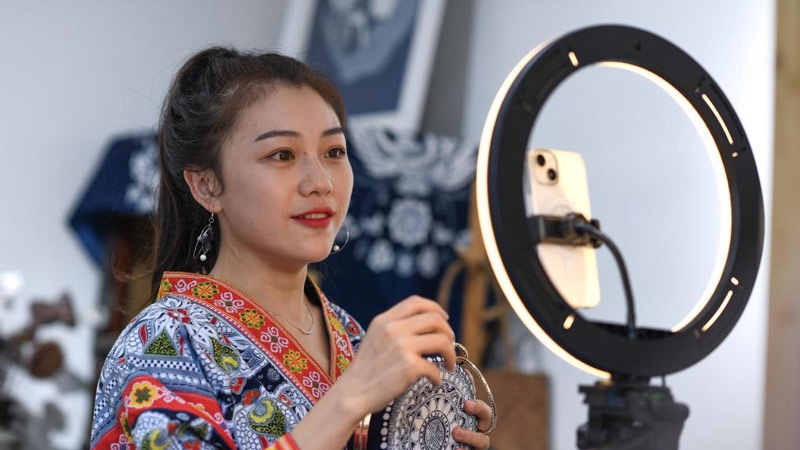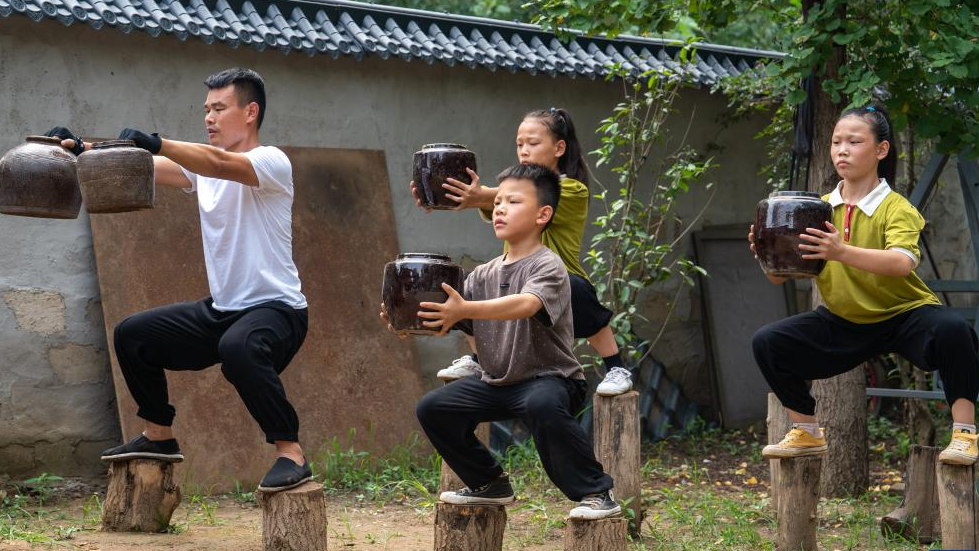Feature: Reviving past glory of Bangladeshi Jamdani with China-made materials
DHAKA, Aug. 30 (Xinhua) -- In June this year Bangladesh wrote a golden chapter of history when the Chinese-built Padma Bridge opened to traffic.
Prime Minister Sheikh Hasina inaugurated the 6.15-km bridge plaque and a beautiful mural, the bottom of which showcases exquisite motifs of Jamdani saree, a traditional women wear that has already been recognized as a Geographical Indication or GI product of Bangladesh.
Tens of thousands of Bangladeshi people are directly and indirectly involved in production of Jamdani, which has also been recognized as a UNESCO Intangible Cultural Heritage of Humanity.
Jamdani is considered as a surviving variety of a fine muslin textile (figured with different patterns) produced for centuries in the present day Rupganj area of Narayanganj district in Bangladesh on the bank of Shitalakhwa river on the outskirts of capital Dhaka.
Weavers in the key center known for the world famous Jamdani textiles has now been making annually hundreds of thousands of pieces of Jamdani which is typically woven using a mixture of cotton and gold thread with geometric and floral designs.
Owing to the colonial import policies favoring industrially manufactured textiles, the Bengali jamdani and muslin industries were almost dying in subsequent centuries.
But in the recent years, the production of jamdani has witnessed a great revival in Bangladesh.
Weavers there said that a wide variety of cheap and available Chinese materials for making exquisite motifs, woven on the loom, could revive the past glory of the Jamdani saree.
Md Milon is a weaver who learned how to weave Jamdani at the age of seven.
When he was 12 or 13 years old while working in workshops, one day he asked his father to bring him a loom so that he can do his own business venture.
"I'm doing well now at my own workshop," said the weaver with indomitable spirit.
"Now eight or nine handlooms are running at my workshop," he told Xinhua recently, giving full credit to the Chinese materials for his business successes in Jamdani production.
"The products that we need to work, like a tool you see in my hand, have the local name of Kontu (weaving tool), this is also from China, then Makku (weaving tool), it also comes from China," said the weaver-turned trader.
Showing a silk thread, he said this is also from China.
"The colors we use are different quality colors, different yarns, they all come from China because the quality of the Chinese materials is good, people of our country use more, that's why we use Chinese materials to produce our products."
Apart from this, Milon said, "The glue we use here is also from China. Without Chinese materials, our products are not developed, that's why we use Chinese materials more, the most."
Sultana Jannat Shiksha is a female entrepreneur.
She runs a shop namely "Purnatha Shilpshala" which mainly deals with indigenous products, notably Jamdani sarees made on handlooms.
"I usually buy Jamdani sarees from this village," she said, "Here the weavers make jamdani. I can buy directly from the weavers. I can see the quality myself."
Usually Chinese colors (dye) are of good quality, she said, adding, "I check whether they use that. I pay attention to this."
Yarn and other materials, such as nylon and silk thread used in making jamdani, are usually procured from China, she noted.
"I check whether it is being used properly."
If the yarn is strong, the weave is good, especially if the saree is made of fine yarn, then it is durable," she said, "I try to give the best to my customers. That is why I myself visit the weavers' factory and try to buy the sarees I like most."
Md Asadullah is a weaver and trader as well. He has been doing this work since his childhood and was abroad for sometime. After returning from abroad he engaged himself in this trade.
"The raw material we use, silk yarn, comes from China, the other yarns we get are the products of our country," said the trader.
He said China's silk yarn is of very good quality. "We get better materials at lower prices from China, and weavers are comfortable working with Chinese materials."
Meanwhile, he said they would like to take advantage of the duty-free (Bangladeshi export) facilities offered by China. "We want these sarees (jamdani fabrics), produced by us, to be sold in the Chinese market."
Photos
Related Stories
- Rail track installation starts on Bangladesh's largest bridge
- In pics: floating guava market in Jhalokati, Bangladesh
- Bangladeshi fishermen restart fishing after 65 days break
- Flood death toll rises to 131 in Bangladesh
- Over 14,000 children die of drowning in Bangladesh each year: WHO, UNICEF
- Feature: All eyes on rail link project after Padma Bridge opens to traffic in Bangladesh
- 160 mln Chinese doses administered as Bangladesh strengthens fight against COVID-19
- People enjoy themselves at beach during Eid al-Adha holiday in Cox's Bazar, Bangladesh
- 8th Bangladesh-China Friendship Bridge ready for inauguration
- China's Red Cross donates 200,000 USD for flood victims in Bangladesh
Copyright © 2022 People's Daily Online. All Rights Reserved.









